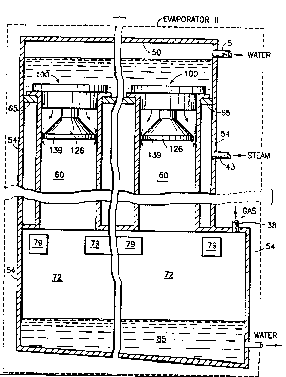Une partie des informations de ce site Web a été fournie par des sources externes. Le gouvernement du Canada n'assume aucune responsabilité concernant la précision, l'actualité ou la fiabilité des informations fournies par les sources externes. Les utilisateurs qui désirent employer cette information devraient consulter directement la source des informations. Le contenu fourni par les sources externes n'est pas assujetti aux exigences sur les langues officielles, la protection des renseignements personnels et l'accessibilité.
L'apparition de différences dans le texte et l'image des Revendications et de l'Abrégé dépend du moment auquel le document est publié. Les textes des Revendications et de l'Abrégé sont affichés :
| (12) Demande de brevet: | (11) CA 2176965 |
|---|---|
| (54) Titre français: | PROCEDE ET DISPOSITIF D'EVAPORATION |
| (54) Titre anglais: | EVAPORATION MEANS AND METHOD |
| Statut: | Réputée abandonnée et au-delà du délai pour le rétablissement - en attente de la réponse à l’avis de communication rejetée |
| (51) Classification internationale des brevets (CIB): |
|
|---|---|
| (72) Inventeurs : |
|
| (73) Titulaires : |
|
| (71) Demandeurs : |
|
| (74) Agent: | SMART & BIGGAR LP |
| (74) Co-agent: | |
| (45) Délivré: | |
| (86) Date de dépôt PCT: | 1994-11-18 |
| (87) Mise à la disponibilité du public: | 1995-06-01 |
| Requête d'examen: | 1996-08-09 |
| Licence disponible: | S.O. |
| Cédé au domaine public: | S.O. |
| (25) Langue des documents déposés: | Anglais |
| Traité de coopération en matière de brevets (PCT): | Oui |
|---|---|
| (86) Numéro de la demande PCT: | PCT/US1994/013378 |
| (87) Numéro de publication internationale PCT: | US1994013378 |
| (85) Entrée nationale: | 1996-05-17 |
| (30) Données de priorité de la demande: | ||||||
|---|---|---|---|---|---|---|
|
Evaporateur (11) dans lequel une chambre (72) sert à recevoir l'eau devant être évaporée. Lorsqu'on chauffe plusieurs tubes (60) de l'évaporateur et que l'eau coule sur une paroi interne d'un tube, ceci a pour effet d'évaporer au moins une partie de cette même eau. Plusieurs distributeurs (100) relient dans l'espace la chambre pour l'eau aux tubes de l'évaporateur de sorte que chaque distributeur (100) distribue uniformément l'eau depuis la chambre pour l'eau jusqu'à une paroi interne d'un tube correspondant. Une source de chaleur sert à chauffer la pluralité de tubes à une température d'évaporation. Un appareil distille la vapeur d'eau résultant de l'évaporation de l'eau pour produire de l'eau distillée.
An evaporator (11), which includes a water chamber
(72) for receiving water to be evaporated. A plurality of
evaporator tubes (60) which when heated, and when water is
on an inner wall of a tube, evaporates at least a portion of that
water. A plurality of distributors (100) spatially connecting
the water chamber with the evaporator tubes in a manner so
that each distributor (100) uniformly and distributes the water
from the water chamber to an inner wall of a corresponding
evaporator tube. A heat source, which heats the plurality of
tubes to an evaporation temperature. Apparatus distills the
water vapor resulting from the water evaporation to provide
distilled water.
Note : Les revendications sont présentées dans la langue officielle dans laquelle elles ont été soumises.
Note : Les descriptions sont présentées dans la langue officielle dans laquelle elles ont été soumises.

2024-08-01 : Dans le cadre de la transition vers les Brevets de nouvelle génération (BNG), la base de données sur les brevets canadiens (BDBC) contient désormais un Historique d'événement plus détaillé, qui reproduit le Journal des événements de notre nouvelle solution interne.
Veuillez noter que les événements débutant par « Inactive : » se réfèrent à des événements qui ne sont plus utilisés dans notre nouvelle solution interne.
Pour une meilleure compréhension de l'état de la demande ou brevet qui figure sur cette page, la rubrique Mise en garde , et les descriptions de Brevet , Historique d'événement , Taxes périodiques et Historique des paiements devraient être consultées.
| Description | Date |
|---|---|
| Le délai pour l'annulation est expiré | 1998-11-18 |
| Demande non rétablie avant l'échéance | 1998-11-18 |
| Réputée abandonnée - omission de répondre à un avis sur les taxes pour le maintien en état | 1997-11-18 |
| Toutes les exigences pour l'examen - jugée conforme | 1996-08-09 |
| Exigences pour une requête d'examen - jugée conforme | 1996-08-09 |
| Demande publiée (accessible au public) | 1995-06-01 |
| Date d'abandonnement | Raison | Date de rétablissement |
|---|---|---|
| 1997-11-18 |
Les titulaires actuels et antérieures au dossier sont affichés en ordre alphabétique.
| Titulaires actuels au dossier |
|---|
| TEXACO DEVELOPMENT CORPORATION |
| Titulaires antérieures au dossier |
|---|
| DINH-CUONG VUONG |